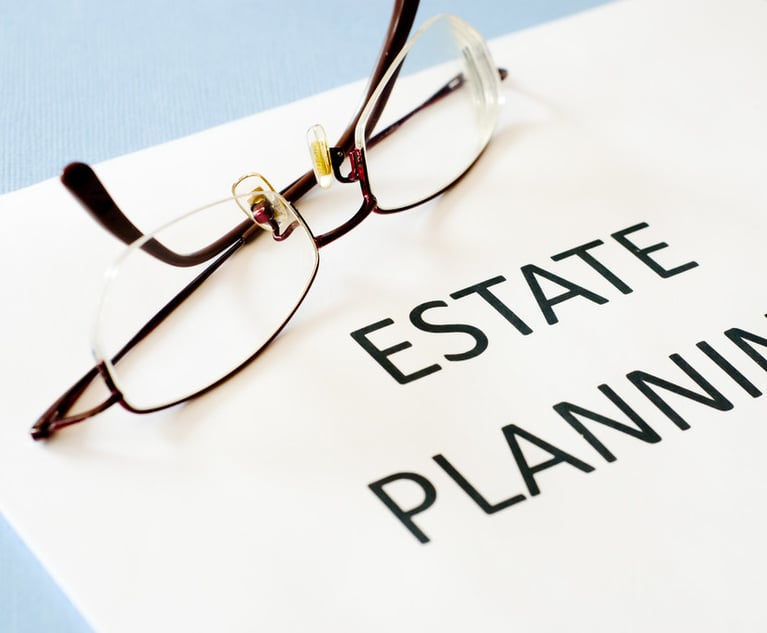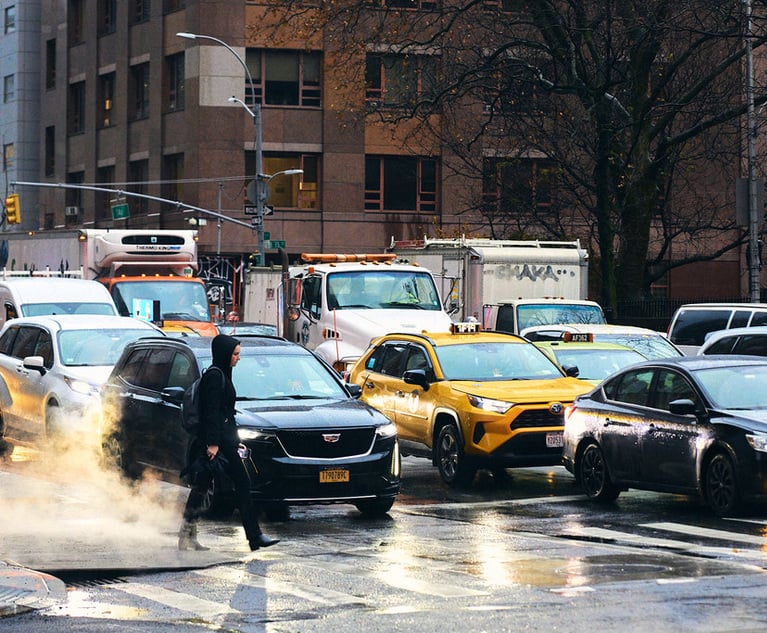 Damage caused by Hurricane Sandy to the New Jersey coast, Oct. 30, 2012. (U.S. Air Force photo by Master Sgt. Mark C. Olsen/Released)
Damage caused by Hurricane Sandy to the New Jersey coast, Oct. 30, 2012. (U.S. Air Force photo by Master Sgt. Mark C. Olsen/Released)Suggested Changes to Municipal Land Use Law in View of Public Health and Safety Concerns
As climate change bears down on New Jersey, communities need maximum flexibility to regulate local development in response to emerging public health and safety concerns.
November 15, 2018 at 10:00 AM
6 minute read
The dire consequences of climate change are arriving sooner than previously thought, and New Jersey is acutely vulnerable. New Jersey has more people living within major coastal flood areas than any other state except for Louisiana and Florida. (Crowell, et al., “An estimate of the U.S. population living in 100-year coastal flood hazard areas,” Journal of Coastal Research, 26(2), March 2010.) Making matters worse, New Jersey's coastal waters are rising faster than the global average, which scientists expect will exacerbate the impacts of storm surge and flooding experienced during major coastal storms and intensifying hurricanes. (Georgetown Climate Ctr. & Rutgers Climate Inst., “Understanding New Jersey's Vulnerability to Climate Change,” https://njadapt.rutgers.edu/docman-lister/working-briefs/75-nj-vulnerabilities/file.)
Even as climate change impacts shift from the realm of the abstract to the concrete, coastal communities and other flood-prone areas face intense development pressure. As became clear in wake of Hurricane Harvey, FEMA's flood maps are subject to piecemeal revisions which can pave the way for unsound development that benefits builders, but harms the public. Schwartz, et al., “Builders Said Their Homes Were Out of a Flood Zone. Then Harvey Came.,” The New York Times (Dec. 2, 2017). Hurricane Sandy, the most destructive hurricane ever recorded in New Jersey, damaged or destroyed 346,000 homes, displaced more than 116,000 people and killed 37 people. In the coming decades, major coastal storms like Sandy will no longer be outliers.
As climate change bears down on New Jersey, communities need maximum flexibility to regulate local development in response to emerging public health and safety concerns. A targeted amendment of the Municipal Land Use Law (MLUL) would provide municipalities with clear authority to apply newly adopted public health and safety regulations to proposed development in areas that are increasingly subject to serious climate change impacts, regardless of whether planning board approval has been issued for the proposed development.
Under the MLUL, the development regulations in effect at the time a developer submits an application to the planning board will control the planning board's decision on the application. (N.J.S.A. 40:55D-10.5, known as the “time of application rule.”) Changes in development regulations which occur after the application was submitted generally will not apply. However, if a municipality adopts new regulations “relating to health and public safety” after the application was submitted, those regulations will apply. This public health and safety exception signals the legislature's intent to protect public health and safety even if doing so interferes with private development plans.
Similarly, once a development application receives preliminary approval from the planning board, the terms and conditions of the approval generally cannot be changed for 3 years—except for changes that “relate to public health and safety.” (N.J.S.A. 40:55D-49.) Here again, the legislature has signaled that the private interest in development is subordinate to the public interest in protecting health and safety.
In fact, the MLUL is replete with such “public health and safety” exceptions, which generally subject private land use to the overriding interest in public health and safety. This is unsurprising, given the primary purpose of the MLUL: to encourage communities to guide land use in a manner which “promotes public health [and] safety.” (N.J.S.A. 40:55D-2.)
What happens if a municipality, responding to a natural disaster or other serious public health or safety situation, adopts new regulations after a development application received final approval—can these new health and public safety regulations be applied to the proposed development? The MLUL provides that developers are shielded from changes in zoning regulations for two years after final approval of a site plan or major subdivision, without an express exception for public health and safety regulations adopted within that time frame. (N.J.S.A. 40:55D-52.) This statutory omission begs the question: Did the legislature intend for public health and safety to yield to private development interests once a final approval has been issued?
The legislature should amend the final approval provision of the MLUL to include an express public health and safety exception. Closing this loophole would not only bring the final approval provision in line with the rest of the statute, it would empower communities to protect themselves from proposed development which poses a serious threat to public health and safety. Legal scholars recognize that vested development rights can subvert the public interest, and “leave[] local governments less able to update and enforce their land use laws to keep pace with changing conditions and evolving views of appropriate land uses.” Calandrillo, Deliganis, Elles, “The Vested Rights Doctrine: How a Shield Against Injustice Became a Sword for Opportunistic Developers,” 78 Ohio St. L.J. 443 (2017).
This local need to keep pace with changing conditions is amplifying as New Jersey communities deal with the impacts of climate change; including more intense hurricanes, rising sea level, beach erosion and increasing coastal and inland flooding. https://www.gfdl.noaa.gov/global-warming-and-hurricanes/; https://19january2017snapshot.epa.gov/sites/production/files/2016-09/documents/climate-change-nj.pdf
Moreover, the amendment would enable communities to address local public health and safety concerns without depending upon the state government to step in. In some cases, a state agency may have approved a proposed development long before a particular public health or safety issue arose, and the state agency may be unwilling to revisit the approval. In such cases, local public health and safety regulations may be the last line of defense against dangerous development.
Some developers or their lawyers may raise concerns that a “public health and safety” exception to final approval could be misused by local government to adopt development regulations that only nominally relate to public health and safety, or that do not address substantial public health and safety concerns, in order to thwart a politically unpopular development proposal. However, bearing in mind both the presumptive validity of municipal action and the courts' repeated admonition that municipal determinations in the context of zoning “should not be approached with a general feeling of suspicion,” such sham “public health and safety” regulations presumably would be subject to legal challenge as zoning for an improper purpose; inverse or reverse spot zoning; arbitrary, capricious and unreasonable municipal action, or the like. Van Itallie v. Borough of Franklin Lakes, 28 N.J. 258 (1958); Paruszewski v. Twp. of Elsinboro, 154 N.J. 45 (1998); Mountain Hill v. Twp. Comm. of Twp. of Middletown, 403 N.J. Super. 146 (App. Div. 2008).
Moreover, cynicism should not stand in the way of common-sense, remedial legislation to bring the final approval provision of the MLUL in line with the statute as a whole and its clear, overriding purpose: protecting public health and safety. Given the impending climate change consequences for New Jersey, that land use objective is now more imperative than ever.
Christopher Miller is an attorney with Maraziti Falcon, in Short Hills. He counsels and litigates on behalf of local public entities in environmental, land use and redevelopment matters, including matters of smart growth and equitable development, environmental justice, environmental infrastructure and climate change resilience.
This content has been archived. It is available through our partners, LexisNexis® and Bloomberg Law.
To view this content, please continue to their sites.
Not a Lexis Subscriber?
Subscribe Now
Not a Bloomberg Law Subscriber?
Subscribe Now
NOT FOR REPRINT
© 2025 ALM Global, LLC, All Rights Reserved. Request academic re-use from www.copyright.com. All other uses, submit a request to [email protected]. For more information visit Asset & Logo Licensing.
You Might Like
View All
New Methods for Clients and Families to Have Their Estate and Legacy Planning Complete
5 minute read
Tensions Run High at Final Hearing Before Manhattan Congestion Pricing Takes Effect
4 minute read

Appreciating the Important Work the Middlesex County Civil Bar Panel Does
7 minute readTrending Stories
- 1To Speed Criminal Discovery, NY Bill Proposes Police-to-Prosecutor Pipeline For Records
- 2Merchan Rejects Trump's Bid to Delay Manhattan Sentencing
- 3High-Low Settlement Agreement 'Does Not Alone Establish Bias:' State High Court Affirms $20M Med Mal Verdict
- 4NYAG Preparing to Withdraw From Defense of Four Correction Officers' Federal Lawsuits
- 52 Judges: Meet the New Chief Justice and the GC Who Just Rose to the Bench
Who Got The Work
Michael G. Bongiorno, Andrew Scott Dulberg and Elizabeth E. Driscoll from Wilmer Cutler Pickering Hale and Dorr have stepped in to represent Symbotic Inc., an A.I.-enabled technology platform that focuses on increasing supply chain efficiency, and other defendants in a pending shareholder derivative lawsuit. The case, filed Oct. 2 in Massachusetts District Court by the Brown Law Firm on behalf of Stephen Austen, accuses certain officers and directors of misleading investors in regard to Symbotic's potential for margin growth by failing to disclose that the company was not equipped to timely deploy its systems or manage expenses through project delays. The case, assigned to U.S. District Judge Nathaniel M. Gorton, is 1:24-cv-12522, Austen v. Cohen et al.
Who Got The Work
Edmund Polubinski and Marie Killmond of Davis Polk & Wardwell have entered appearances for data platform software development company MongoDB and other defendants in a pending shareholder derivative lawsuit. The action, filed Oct. 7 in New York Southern District Court by the Brown Law Firm, accuses the company's directors and/or officers of falsely expressing confidence in the company’s restructuring of its sales incentive plan and downplaying the severity of decreases in its upfront commitments. The case is 1:24-cv-07594, Roy v. Ittycheria et al.
Who Got The Work
Amy O. Bruchs and Kurt F. Ellison of Michael Best & Friedrich have entered appearances for Epic Systems Corp. in a pending employment discrimination lawsuit. The suit was filed Sept. 7 in Wisconsin Western District Court by Levine Eisberner LLC and Siri & Glimstad on behalf of a project manager who claims that he was wrongfully terminated after applying for a religious exemption to the defendant's COVID-19 vaccine mandate. The case, assigned to U.S. Magistrate Judge Anita Marie Boor, is 3:24-cv-00630, Secker, Nathan v. Epic Systems Corporation.
Who Got The Work
David X. Sullivan, Thomas J. Finn and Gregory A. Hall from McCarter & English have entered appearances for Sunrun Installation Services in a pending civil rights lawsuit. The complaint was filed Sept. 4 in Connecticut District Court by attorney Robert M. Berke on behalf of former employee George Edward Steins, who was arrested and charged with employing an unregistered home improvement salesperson. The complaint alleges that had Sunrun informed the Connecticut Department of Consumer Protection that the plaintiff's employment had ended in 2017 and that he no longer held Sunrun's home improvement contractor license, he would not have been hit with charges, which were dismissed in May 2024. The case, assigned to U.S. District Judge Jeffrey A. Meyer, is 3:24-cv-01423, Steins v. Sunrun, Inc. et al.
Who Got The Work
Greenberg Traurig shareholder Joshua L. Raskin has entered an appearance for boohoo.com UK Ltd. in a pending patent infringement lawsuit. The suit, filed Sept. 3 in Texas Eastern District Court by Rozier Hardt McDonough on behalf of Alto Dynamics, asserts five patents related to an online shopping platform. The case, assigned to U.S. District Judge Rodney Gilstrap, is 2:24-cv-00719, Alto Dynamics, LLC v. boohoo.com UK Limited.
Featured Firms
Law Offices of Gary Martin Hays & Associates, P.C.
(470) 294-1674
Law Offices of Mark E. Salomone
(857) 444-6468
Smith & Hassler
(713) 739-1250






